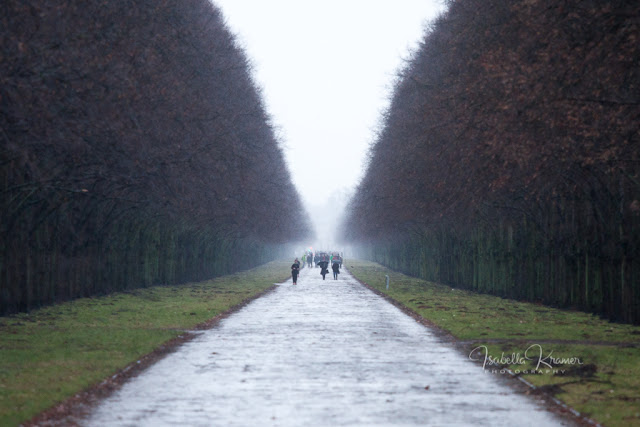.
It's a silent time in winter, because the Convent of Wienhausen can only be visited in a guided tour.
Guided tours take place starting 1st April until October. But you can enjoy the beautiful architecture in winter and the peaceful atmosphere of the lovely village Wienhausen.
The Convent of Wienhausen was the home of major cultural and historic advances related to early religion in German society. The world’s oldest eyeglasses are also located there. The convent was founded between 1221 and 1228 by Duchess Agnes of Landsburg (who died 1248), the widow of Henry (Heinrich), Count Palatine of the Rhine, and the elder son of Henry the Lion, Duke of Saxony. Duchess Agnes had also founded the convent of Isenhagen. She probably founded the convent as a means of salvation for her sins and those of her husband. At that time the foundation of the convent received much support from Bishop Conrad 2nd of Hildesheim. According to the chronicle of the convent, it was first established in 1221 in Nienhagen, near Celle. About 1231 it was moved to Wienhausen due to mosquitoes, "poisonous worms," and bad air. Two years later it was officially confirmed by Bishop Konrad the Second. A document dated April 24, 1233 is still one of the most valuable pieces of the convent’s own archive. In 1244 Duke Otto requested the convent's incorporation into the Cistercian Order. Much debate revolves around whether Wienhausen was actually incorporated into the order. The request survives but not the answer. Most scholars agree that Wienhausen followed Cistercian customs but was likely not formally incorporated into the order. The convent was then rebuilt in the North German red brickwork style with its characteristic Gothic gables from about 1310 to 1330 by the generosity of the widow resident Princess Mechtild.
The Rule at that time was Benedictine. The convent developed strong ties with convents in both Derneburg and Medingen. The community was supported by the neighboring nobles and patrician families of Lueneberg and Braunschweig. Members of the Welf family were continual patrons of the community. The abbesses of the community stemmed predominantly from nobility so therefore, during the first 200 years of its existence, the convent reached the peak of its cultural and material wealth. The convent derived income from land holding, rents, tithes, patronage rights, and rights and possessions in the Lueneburg salt works. In total, Wienhausen had patronage rights in six churches. The nuns probably contributed to the convent’s income by producing and selling tapestries and embroidery work. There is an abundance of famous artwork in the nun’s choir which originally had 89 seats, though the population was probably lower throughout that time period. The number sank into the 20’s in the 17th century and remained that way into the 20th century. The nuns of Wienhausen did not approve of the Reformation and so had to be forced to accept it. In the process, many precious objects and buildings were taken away or destroyed. In 1587 the last catholic abbess died and finally the nunnery became a protestant convent. For years to come however the women would continue to hold secret Catholic services. Built originally c. 1330 the Nun’s choir has both wall and ceiling paintings which depict scenes from the Old and the New Testament. Also portrayed are scenes from the life and the Passion of the Christ. The images below of some of the ceiling paintings should be viewed slowly in order to fully appreciate the exquisite 14th century religious art.
©www.antiquespectacles.com
Hallo lieber Gast
Hallo lieber Gast, willkommen in den klaren Weiten im Norden Deutschlands, begleite mich auf meinen Pfaden durch die Natur, Ausflügen und Reisen, auf der Suche nach Ruhe und Anregung. Entdecke mit mir Linien und Freiräumen, die die Perspektiven, die Vielfalt der Farben und Formen dieser Welt und unserer Natur uns bieten und genieße Momente der Nachdenklichkeit, Poesie und philosophischen Worte großer Dichter und Denker, manchmal auch meine eigenen lyrischen Texte dazu.
Schön, dass Du Dir die Zeit genommen hast - wunderbar, Dich hier zur wissen!
" Ich muss mich ganz im Stillen mit meiner Außenwelt reiben,. sonst werde ich untauglich für die Welt."
- Paula Modersohn-Becker
Schön, dass Du Dir die Zeit genommen hast - wunderbar, Dich hier zur wissen!
- Paula Modersohn-Becker
My North - the Convent of Wienhausen
8 Kommentare:
original created by
isabella kramer - veredit
Labels:
buildings,
City & Architecture,
Friedhof,
Geschichte,
Himmel,
History,
Kloster,
mein Norden,
MySundayPhoto,
Norddeutschland,
our world tuesday,
Park,
Skywatch Friday,
urban,
Wienhausen,
Winter
It's Springing
.
.
"The flowers of late winter and early spring occupy places in our hearts
well out of proportion to their size."
- Gertrude S. Wister
.
My North - A February Poem
.
.
"The birds are gone, The ground is white,
The winds are wild, They chill and bite;
The ground is thick with slush and sleet,
And I barely feel my feet."
- Cecil Frances Alexander
.
9 Kommentare:
original created by
isabella kramer - veredit
Labels:
Bäume,
City & Architecture,
February,
Hannover,
Herrenhäuser Gärten,
mein Norden,
Menschen,
MySundayPhoto,
Nebel,
our world tuesday,
Park,
Regen,
Skywatch Friday,
Stadtgeschichten,
urban,
Winter
When it's working
.
.
”When it is working, you completely go into another place, you’re tapping into things that are totally universal,
completely beyond your ego and your own self. That’s what it’s all about.”
~ Keith Haring
.
Abonnieren
Posts (Atom)










